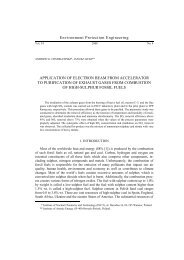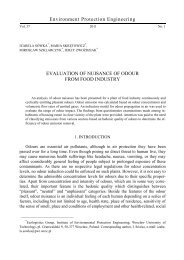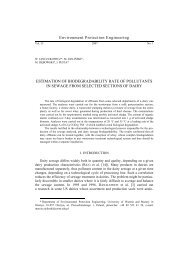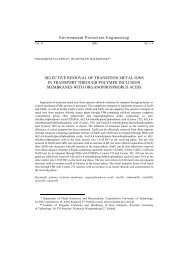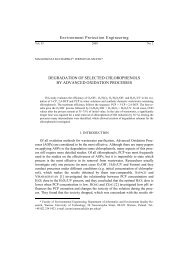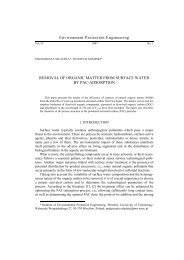Microbial degradation of phenol by activated sludge in a batch reactor
Microbial degradation of phenol by activated sludge in a batch reactor
Microbial degradation of phenol by activated sludge in a batch reactor
You also want an ePaper? Increase the reach of your titles
YUMPU automatically turns print PDFs into web optimized ePapers that Google loves.
Environment Protection Eng<strong>in</strong>eer<strong>in</strong>g<br />
Vol. 37 2011 No. 2<br />
ZONGYIN DUAN*<br />
MICROBIAL DEGRADATION OF PHENOL<br />
BY ACTIVATED SLUDGE IN A BATCH REACTOR<br />
Bio<strong>degradation</strong> <strong>of</strong> <strong>phenol</strong> <strong>in</strong> a <strong>batch</strong> <strong>reactor</strong> was <strong>in</strong>vestigated us<strong>in</strong>g <strong>activated</strong> <strong>sludge</strong>. The <strong>sludge</strong><br />
was able to degrade <strong>phenol</strong> <strong>of</strong> <strong>in</strong>itial concentrations up to 1.500 mg/dm 3 . The optimum temperature<br />
and pH for the reaction were determ<strong>in</strong>ed <strong>in</strong> extensive tests. The optimum pH was around 6, whereas<br />
the temperature showed no significant impact on the bio<strong>degradation</strong> rates over the <strong>in</strong>vestigated conditions.<br />
This <strong>activated</strong> <strong>sludge</strong> degraded <strong>phenol</strong> at the maximum rate <strong>of</strong> 0.048 g <strong>phenol</strong>/(g VSS·h) at pH<br />
6 and 30 °C, whereas <strong>in</strong>hibitory effects existed at concentrations higher than 100 mg/dm 3 . The<br />
Haldane k<strong>in</strong>etic model was used to elucidate the k<strong>in</strong>etics <strong>of</strong> <strong>phenol</strong> <strong>degradation</strong> <strong>in</strong> an <strong>activated</strong><br />
<strong>sludge</strong>. The k<strong>in</strong>etic parameters were estimated to be q max = 0.4695 g <strong>phenol</strong>/(g VSS·h), K I = 28.4860<br />
mg/dm 3 , and K S = 603.9869 mg/dm 3 , with the correlation coefficient (R 2 ) <strong>of</strong> 0.9599. The high q max<br />
value for <strong>phenol</strong> bio<strong>degradation</strong> shows that the <strong>activated</strong> <strong>sludge</strong> exhibited high resistance to <strong>phenol</strong>.<br />
1. INTRODUCTION<br />
Phenols and <strong>phenol</strong>ic compounds orig<strong>in</strong>ated from oil ref<strong>in</strong>eries, pulp and paper<br />
manufactur<strong>in</strong>g plants, res<strong>in</strong>s and coke manufactur<strong>in</strong>g, steel and pharmaceutical <strong>in</strong>dustries<br />
are toxic to human be<strong>in</strong>gs, fish and to several biochemical functions [1–5]. Increas<strong>in</strong>g<br />
presence <strong>of</strong> <strong>phenol</strong>s represents a significant environmental toxicity hazard.<br />
Wastewaters <strong>in</strong>clud<strong>in</strong>g <strong>phenol</strong>s and <strong>phenol</strong>ic compounds must be treated <strong>in</strong> order not<br />
to be a threat with human health and not to lead to serious ecological risks [6–8]. Increas<strong>in</strong>gly<br />
str<strong>in</strong>gent restrictions have been imposed on the concentrations <strong>of</strong> these<br />
compounds <strong>in</strong> wastewaters for safe discharge. Thus, the approach for the removal <strong>of</strong><br />
<strong>phenol</strong>s from <strong>in</strong>dustrial wastewater has generated significant <strong>in</strong>terest [9–14].<br />
Several methods with different removal performance and cost levels are available<br />
for the treatment <strong>of</strong> <strong>phenol</strong>ic wastewaters. Either conventional physicochemical<br />
[9, 10] or biological [15–19] techniques may be used. However, these treatments are<br />
very complex and expensive. This situation is trigger<strong>in</strong>g the development <strong>of</strong> new<br />
_________________________<br />
*Department <strong>of</strong> Mechanical Eng<strong>in</strong>eer<strong>in</strong>g, Tongl<strong>in</strong>g University, Tongl<strong>in</strong>g, 244000 Ch<strong>in</strong>a, e-mail:<br />
dzy@tlu.edu.cn
54<br />
Z. DUAN<br />
treatment technologies for <strong>phenol</strong>ic wastewater. Biological treatment has been shown<br />
to be economical, practical and the most promis<strong>in</strong>g and versatile approach as it leads<br />
to complete m<strong>in</strong>eralization <strong>of</strong> <strong>phenol</strong> with low possibility <strong>of</strong> the production <strong>of</strong> <strong>by</strong>products<br />
[15, 16, 19]. In this viewpo<strong>in</strong>t, the application <strong>of</strong> bio<strong>degradation</strong> process to metabolize<br />
the <strong>phenol</strong>ic wastewater appears to be an alternative to conventional treatment<br />
processes.<br />
However, the toxicity <strong>of</strong> <strong>phenol</strong>ic compounds may <strong>in</strong>hibit or even reduce microorganisms<br />
<strong>in</strong> municipal biological wastewater treatment plant [20]. The presence <strong>of</strong><br />
<strong>phenol</strong>s strongly reduces biological bio<strong>degradation</strong> <strong>of</strong> other components which makes<br />
the process <strong>of</strong> <strong>degradation</strong> <strong>of</strong> <strong>phenol</strong>s so difficult. It is the reason why <strong>activated</strong> <strong>sludge</strong><br />
<strong>reactor</strong>s have been widely used for <strong>phenol</strong> removal from <strong>in</strong>dustrial wastewater. Batch<br />
<strong>reactor</strong> processes employ<strong>in</strong>g either suspended or immobilized cultures are <strong>in</strong> use for<br />
the <strong>degradation</strong> <strong>of</strong> toxic compounds. The <strong>activated</strong> <strong>sludge</strong> process is generally a preferred<br />
biological process for the treatment <strong>of</strong> <strong>in</strong>dustrial wastewaters <strong>in</strong>clud<strong>in</strong>g <strong>phenol</strong>s<br />
[15, 16, 19, 21–24].<br />
Presently, great restrictions to application <strong>of</strong> biological processes are related to the<br />
acclimation <strong>of</strong> the biomass to <strong>phenol</strong> bio<strong>degradation</strong> and variability <strong>of</strong> wastewater<br />
composition. A simple and effective method to obta<strong>in</strong> a specified biomass from <strong>activated</strong><br />
<strong>sludge</strong> for <strong>phenol</strong>s treatment is highly desired, which provides selection and<br />
multiplication <strong>of</strong> specialized microorganisms. Furthermore, <strong>phenol</strong> <strong>degradation</strong> seems<br />
to be <strong>in</strong>fluenced <strong>by</strong> some environmental factors such as temperature and pH. This<br />
issue should also be explored for its full application, as well as the substrate <strong>in</strong>hibition<br />
effect and the related bio<strong>degradation</strong> k<strong>in</strong>etics. Thus, to acclimatize bacteria to <strong>phenol</strong><br />
under experimental conditions easier to implement and to <strong>in</strong>vestigate the possibility <strong>of</strong><br />
<strong>phenol</strong> bio<strong>degradation</strong> at high <strong>in</strong>itial concentrations and to study the <strong>phenol</strong> bio<strong>degradation</strong><br />
k<strong>in</strong>etics motivates this work.<br />
Therefore, the aim <strong>of</strong> this work was to evaluate the microbial <strong>degradation</strong> <strong>of</strong> <strong>phenol</strong><br />
<strong>by</strong> <strong>activated</strong> <strong>sludge</strong> <strong>in</strong> a <strong>batch</strong> <strong>reactor</strong>. The k<strong>in</strong>etics <strong>of</strong> <strong>phenol</strong> removal <strong>in</strong> a <strong>batch</strong><br />
<strong>reactor</strong> was <strong>in</strong>vestigated <strong>in</strong> order to develop <strong>activated</strong> <strong>sludge</strong> process that could effectively<br />
treat <strong>phenol</strong>s. The microbial process reported here could potentially be applied<br />
to remove <strong>phenol</strong>s and <strong>phenol</strong>ic compounds <strong>in</strong> <strong>in</strong>dustrial effluents.<br />
2. MATERIALS AND METHODS<br />
Experimental system. The experimental system was a fully mixed bench scale <strong>reactor</strong><br />
with a constant temperature water circulator and monitor<strong>in</strong>g device for temperature,<br />
dissolved oxygen (DO) and pH. The work<strong>in</strong>g volume <strong>of</strong> the <strong>reactor</strong> was 2 dm 3 .<br />
The <strong>reactor</strong> had a water jacket for controll<strong>in</strong>g the temperature which was kept constant<br />
at each test. The air velocity <strong>of</strong> 0.3 m 3 ·h –1 was applied to the <strong>reactor</strong>. The DO concentration<br />
<strong>of</strong> the mixed liquor was controlled us<strong>in</strong>g the aeration ON/OFF controller. Air
<strong>Microbial</strong> <strong>degradation</strong> <strong>of</strong> <strong>phenol</strong> <strong>by</strong> <strong>activated</strong> <strong>sludge</strong> <strong>in</strong> a <strong>batch</strong> <strong>reactor</strong> 55<br />
was <strong>in</strong>troduced <strong>by</strong> an air pump from the <strong>reactor</strong> bottom. The dissolved oxygen (DO)<br />
level was kept over 4 mg/dm 3 <strong>in</strong> the aeration phase. The <strong>reactor</strong> was operated under<br />
<strong>batch</strong> operation and the stirr<strong>in</strong>g speed was adjusted to 100 rpm. The <strong>reactor</strong> was operated<br />
sequentially with<strong>in</strong> a 6 h cycle, <strong>in</strong>clud<strong>in</strong>g 5 m<strong>in</strong> <strong>of</strong> <strong>in</strong>fluent fill<strong>in</strong>g, 325 m<strong>in</strong> <strong>of</strong><br />
aeration, 20 m<strong>in</strong> <strong>of</strong> settl<strong>in</strong>g, and 10 m<strong>in</strong> <strong>of</strong> effluent discharg<strong>in</strong>g. Effluent was drawn<br />
from the middle port <strong>of</strong> the <strong>reactor</strong> column (1 dm 3 ), and the result<strong>in</strong>g hydraulic retention<br />
time (HRT) was 12 h. Samples were taken from the <strong>reactor</strong> at predeterm<strong>in</strong>ed time<br />
<strong>in</strong>tervals us<strong>in</strong>g a peristaltic pump. The desired SRT was set <strong>by</strong> controll<strong>in</strong>g the amount<br />
<strong>of</strong> <strong>sludge</strong> wasted from the <strong>reactor</strong> <strong>in</strong> each cycle. About 1.5 dm 3 <strong>of</strong> seed<strong>in</strong>g <strong>sludge</strong> were<br />
<strong>in</strong>oculated <strong>in</strong>to the SBR, result<strong>in</strong>g <strong>in</strong> a mixed liquor suspended solid (MLSS) concentration<br />
<strong>of</strong> about 4.5 g/dm 3 <strong>in</strong> the <strong>reactor</strong>, and correspond<strong>in</strong>gly the load<strong>in</strong>g rate was<br />
about 0.1 kg <strong>phenol</strong>/(m 3 ·d).<br />
Source <strong>of</strong> <strong>sludge</strong> and wastewater. The <strong>phenol</strong> remov<strong>in</strong>g <strong>sludge</strong> used <strong>in</strong> the experiments<br />
was developed from an <strong>activated</strong> <strong>sludge</strong> collected from a wastewater treatment<br />
plant <strong>in</strong> Ch<strong>in</strong>a. The seed<strong>in</strong>g <strong>sludge</strong> had a <strong>sludge</strong> age <strong>of</strong> 10 d, a mixed liquor suspended<br />
solids (MLSS) concentration <strong>of</strong> 6.0 g/dm 3 and the <strong>sludge</strong> volume <strong>in</strong>dex (SVI) <strong>of</strong><br />
70 cm 3 /g. The <strong>sludge</strong> was acclimatized for 40 days <strong>in</strong> aerobic and <strong>phenol</strong> conta<strong>in</strong><strong>in</strong>g<br />
wastewater before be<strong>in</strong>g used <strong>in</strong> experiments. The acclimatized culture was brown <strong>in</strong><br />
colour and had fluffy, irregular and loose structure floc morphology, and filamentous<br />
bacteria could be well observed <strong>in</strong> the flocs. The synthetic contam<strong>in</strong>ated wastewater<br />
was prepared from distilled water us<strong>in</strong>g <strong>phenol</strong> as the contam<strong>in</strong>ant. The synthetic<br />
wastewater used <strong>in</strong> the <strong>batch</strong> growth studies comprised (dm –3 ): 227 mg (NH4)2SO4,<br />
100 mg MgSO4·7H2O, 0.5 mg FeCl3, 100 mg MnSO4·H2O, 7.5 mg CaCl2, 250 mg<br />
KH2PO4, and 500 mg K2HPO4.<br />
Phenols bio<strong>degradation</strong> tests. The presence <strong>of</strong> <strong>phenol</strong>s <strong>in</strong> wastewater varied<br />
widely from over ten to thousands <strong>in</strong> concentrations (mg/dm 3 ). In addition, the toxicity<br />
<strong>of</strong> <strong>phenol</strong>s that <strong>in</strong>hibit microorganisms might <strong>in</strong>crease upon <strong>in</strong>creas<strong>in</strong>g concentration<br />
<strong>of</strong> <strong>phenol</strong>s [1]. Thus, <strong>in</strong> this work, the concentrations <strong>of</strong> <strong>phenol</strong> for bio<strong>degradation</strong><br />
tests were selected <strong>in</strong> a wide range based on reported literature values. The tests were<br />
started <strong>by</strong> <strong>in</strong>oculat<strong>in</strong>g synthetic wastewater conta<strong>in</strong><strong>in</strong>g 50–1500 mg/dm 3 <strong>of</strong> <strong>phenol</strong> and<br />
the acclimatized <strong>sludge</strong> to the <strong>reactor</strong> at 30 °C. Thus, the <strong>in</strong>itial <strong>phenol</strong> /biomass (F/M)<br />
ratios were 0.007–0.2 mg <strong>phenol</strong> /mg VSS (VSS is volatile suspended solid). The pH,<br />
biomass amount, and <strong>phenol</strong> concentrations <strong>of</strong> samples <strong>in</strong> <strong>reactor</strong>s were measured at<br />
predeterm<strong>in</strong>ed time <strong>in</strong>tervals. The optimum temperature and pH for the bio<strong>degradation</strong><br />
were determ<strong>in</strong>ed <strong>in</strong> extensive tests. The pH values adjusted <strong>by</strong> phosphate buffer were<br />
<strong>in</strong> the range 5.0–8.0. The phosphate buffers were prepared <strong>by</strong> mix<strong>in</strong>g various volume<br />
fractions <strong>of</strong> 0.375 g/dm 3 <strong>of</strong> K2HPO4 and 0.42 g/dm 3 <strong>of</strong> KH2PO4 solutions <strong>in</strong> deionized<br />
water (Millipore, Milli-Q). Control experiments, <strong>in</strong> a <strong>sludge</strong>-free medium which only<br />
<strong>in</strong>cluded <strong>phenol</strong> and other constituents, were also done <strong>in</strong> order to evaluate the possi-
56<br />
Z. DUAN<br />
ble degree <strong>of</strong> <strong>phenol</strong> removal with volatilization and it was found that the <strong>phenol</strong> concentration<br />
almost rema<strong>in</strong>ed unchanged. All the experiments were run <strong>in</strong> triplicate and<br />
the averaged results were reported here.<br />
Analytical methods. Phenol concentration <strong>in</strong> suspension was measured us<strong>in</strong>g<br />
4-am<strong>in</strong>oantipyr<strong>in</strong>e colorimetric approach on supernatant drawn from samples centrifuged<br />
at 8000 rpm for 10 m<strong>in</strong>. pH was determ<strong>in</strong>ed <strong>by</strong> us<strong>in</strong>g a pH meter. Measurements<br />
<strong>of</strong> VSS were conducted <strong>in</strong> accordance with the standard methods [25]. Determ<strong>in</strong>ation<br />
<strong>of</strong> bio<strong>degradation</strong> rates and parameters <strong>of</strong> the Haldane equation were done<br />
on a personal computer <strong>by</strong> us<strong>in</strong>g a spreadsheet program (Micros<strong>of</strong>t Excel 2003).<br />
3. RESULTS AND DISCUSSION<br />
3.1. PERFORMANCE OF BIODEGRADATION OF PHENOLS<br />
The <strong>activated</strong> <strong>sludge</strong> was grown <strong>in</strong> the presence <strong>of</strong> <strong>phenol</strong> as the sole carbon<br />
source and adapted to <strong>in</strong>creas<strong>in</strong>g concentrations <strong>of</strong> <strong>phenol</strong> over a period <strong>of</strong> 40 days;<br />
the <strong>reactor</strong> was cont<strong>in</strong>uously operated dur<strong>in</strong>g this period. The <strong>sludge</strong> is supposed to be<br />
acclimated to the system when <strong>phenol</strong> is completely degraded <strong>in</strong> repeated uses <strong>in</strong> fixed<br />
time <strong>in</strong>tervals. The performance <strong>of</strong> the <strong>activated</strong> <strong>sludge</strong> to degrade <strong>phenol</strong> was evaluated<br />
<strong>by</strong> monitor<strong>in</strong>g <strong>phenol</strong> disappearance at its various concentrations <strong>in</strong> the <strong>batch</strong><br />
<strong>reactor</strong>. Figure 1 shows results <strong>of</strong> <strong>batch</strong> tests for <strong>phenol</strong> <strong>degradation</strong> <strong>by</strong> <strong>activated</strong><br />
<strong>sludge</strong> at 30 °C. At <strong>in</strong>itial <strong>phenol</strong> concentrations <strong>of</strong> 50–1500 mg/dm 3 , <strong>phenol</strong> concentration<br />
quickly decreased for all tests when <strong>phenol</strong> concentration was sufficient. For<br />
example, at an <strong>in</strong>itial <strong>phenol</strong> concentration <strong>of</strong> 200 mg/dm 3 , the <strong>degradation</strong> reached<br />
75% <strong>in</strong> 3 h. However, <strong>phenol</strong> concentrations <strong>in</strong> the <strong>batch</strong> <strong>reactor</strong> decreased with time<br />
rather steeply at low <strong>in</strong>itial <strong>phenol</strong> contents as compared to those conta<strong>in</strong><strong>in</strong>g high levels<br />
<strong>of</strong> <strong>phenol</strong>. S<strong>in</strong>ce the <strong>phenol</strong> contents <strong>of</strong> the control <strong>reactor</strong>s did not change significantly<br />
(
<strong>Microbial</strong> <strong>degradation</strong> <strong>of</strong> <strong>phenol</strong> <strong>by</strong> <strong>activated</strong> <strong>sludge</strong> <strong>in</strong> a <strong>batch</strong> <strong>reactor</strong> 57<br />
<strong>in</strong> 0.8 and 1.8 h, respectively. At 200, 400, and 800 mg/dm 3 , the time lag <strong>of</strong> 2, 4, and<br />
8 h was observed, after which <strong>phenol</strong> was completely degraded. At the <strong>in</strong>itial concentration<br />
<strong>of</strong> 1500 mg/dm 3 , the lag time was 15 h and the time needed for complete <strong>phenol</strong><br />
bio<strong>degradation</strong> was prolonged to 40 h. Furthermore, the average <strong>phenol</strong> bio<strong>degradation</strong><br />
rates decreased upon <strong>in</strong>creas<strong>in</strong>g <strong>in</strong>itial <strong>phenol</strong> concentrations from 50 mg/dm 3<br />
to 1500 mg/dm 3 , suggest<strong>in</strong>g the <strong>in</strong>hibition to bacteria <strong>by</strong> high <strong>in</strong>itial concentrations <strong>of</strong><br />
<strong>phenol</strong>s.<br />
Fig. 1. Batch tests results <strong>of</strong> <strong>phenol</strong> bio<strong>degradation</strong> <strong>by</strong> <strong>activated</strong><br />
<strong>sludge</strong> with various <strong>in</strong>itial <strong>phenol</strong> concentrations at 30 °C and pH <strong>of</strong> 6:<br />
a) 50, 100, 200 mg/dm 3 , b) 400, 800, 1500 mg/dm 3<br />
Figure 1 also shows that for the same <strong>in</strong>itial biomass concentration the higher the<br />
concentration <strong>of</strong> <strong>phenol</strong> is the more time it takes to be consumed. The <strong>phenol</strong> concen-
58<br />
Z. DUAN<br />
tration <strong>in</strong> the culture medium decreases clearly due to utilization <strong>by</strong> microorganisms as<br />
they grow. The growth rate should be higher when <strong>phenol</strong> concentration decreased<br />
because <strong>of</strong> a substrate <strong>in</strong>hibition phenomenon. The extent <strong>of</strong> <strong>phenol</strong> <strong>degradation</strong> and<br />
the time required depends on the <strong>in</strong>itial <strong>phenol</strong> concentration <strong>in</strong> the medium.<br />
3.3. EFFECT OF TEMPERATURE AND PH TO BIODEGRADATION OF PHENOLS<br />
Degradation <strong>of</strong> <strong>phenol</strong> seems to be dependent on some environmental factors such<br />
as temperature and pH [2, 29, 30]. Effect <strong>of</strong> temperature and pH was performed to<br />
explore their optimum values for bio<strong>degradation</strong> <strong>of</strong> <strong>phenol</strong>s <strong>by</strong> the <strong>activated</strong> <strong>sludge</strong> <strong>in</strong><br />
the <strong>batch</strong> <strong>reactor</strong>.<br />
Fig. 2. Batch tests for <strong>phenol</strong> bio<strong>degradation</strong> <strong>by</strong> the <strong>activated</strong> <strong>sludge</strong><br />
at the <strong>in</strong>itial <strong>phenol</strong> concentration <strong>of</strong> 400 mg/dm 3 : a) effects <strong>of</strong> pH (5–8),<br />
b) effects <strong>of</strong> temperature (25–40 °C)
<strong>Microbial</strong> <strong>degradation</strong> <strong>of</strong> <strong>phenol</strong> <strong>by</strong> <strong>activated</strong> <strong>sludge</strong> <strong>in</strong> a <strong>batch</strong> <strong>reactor</strong> 59<br />
Figure 2 shows the results <strong>of</strong> <strong>batch</strong> tests at various pH and temperatures at the <strong>in</strong>itial<br />
<strong>phenol</strong> concentration <strong>of</strong> 400 mg/dm 3 . Phenol was completely biodegraded at pH<br />
5–6 and at 30 °C while not depleted at pH 7–8. In comparison, the bio<strong>degradation</strong> <strong>of</strong><br />
<strong>phenol</strong>s performance did not change much at 25–40 °C. The optimum pH for <strong>phenol</strong><br />
<strong>degradation</strong> is around 6, whereas the temperature has shown no significant impact on<br />
the reaction rates over the <strong>in</strong>vestigated conditions.<br />
Regard<strong>in</strong>g the temperature effect, there are opposite experimental results <strong>in</strong> previous<br />
work [2, 19, 26, 31]. It has been reported that temperature could play an important<br />
role <strong>in</strong> the <strong>degradation</strong> <strong>of</strong> <strong>phenol</strong> [31]. Many authors f<strong>in</strong>d higher efficiency <strong>of</strong> <strong>phenol</strong><br />
removal near 30 °C [2, 26, 28]. Chung et al. [28] found an optimum temperature <strong>of</strong><br />
30 °C for the two processes for immobilized cells and free cells. It is probably due to<br />
the higher production <strong>of</strong> metabolites at this temperature [29]. However, the rate and<br />
the extent <strong>of</strong> <strong>degradation</strong> is relatively sensitive to deviations outside the optimum<br />
range [26]. Adav et al. [19] found that temperature <strong>of</strong> 25–40 °C had no noticeable<br />
effect on the growth rate when us<strong>in</strong>g a stra<strong>in</strong> with maximum ability to degrade <strong>phenol</strong><br />
and a high tolerance to <strong>phenol</strong> toxicity isolated from an aerobic granule identified as<br />
Candida tropicalis. In short, it appears that bio<strong>degradation</strong> <strong>of</strong> <strong>phenol</strong> could occur at<br />
room temperature. Different <strong>sludge</strong> system might be a reason for different experimental<br />
results. Additionally, different wastewater characteristics, <strong>reactor</strong> operat<strong>in</strong>g conditions<br />
and microbial communities also are responsible for the differences.<br />
The follow-up <strong>of</strong> the medium pH can be an <strong>in</strong>dicator <strong>of</strong> the <strong>phenol</strong> <strong>degradation</strong> and<br />
one <strong>of</strong> the factors significant <strong>in</strong> the success <strong>of</strong> the biological treatment. A slight reduction<br />
is observed as biomass grows and pH variation <strong>in</strong>creases when the <strong>in</strong>itial <strong>phenol</strong><br />
concentration <strong>in</strong>creases [12, 32]. The decrease <strong>in</strong> pH suggests that biological <strong>degradation</strong><br />
<strong>of</strong> <strong>phenol</strong> occurs and with a stable pH <strong>phenol</strong> is successfully degraded as shown<br />
<strong>in</strong> this work. pH significantly affects biochemical reactions required for <strong>phenol</strong> <strong>degradation</strong>.<br />
For <strong>in</strong>stance, pure P. putida could not efficiently resist pH change [2]. Consequently,<br />
<strong>phenol</strong> <strong>degradation</strong> may be deteriorated as medium pH deviates. Aksu and<br />
Gonen [33] found that pH affects the surface charge <strong>of</strong> cells <strong>of</strong> the <strong>activated</strong> <strong>sludge</strong><br />
biomass. Thus, the electrostatic attraction between <strong>phenol</strong> and <strong>activated</strong> <strong>sludge</strong> biomass<br />
would be impacted [33]. In conclusion, it seems that the best pH range for the<br />
<strong>phenol</strong> <strong>degradation</strong> does exist. It is possible that enzymes for <strong>phenol</strong> <strong>degradation</strong> have<br />
their optimum enzymatic activities at an optimum pH. However, the optimum pH for<br />
differs from one bacterium to another. For example, pH ranges between 8 and 11 were<br />
found for the bacterium Halomonas campisalis and for the bio<strong>degradation</strong> <strong>of</strong> <strong>phenol</strong><br />
<strong>by</strong> Klebsiella oxytoca, pH was 6.8 [34].<br />
3.4. KINETICS OF BIODEGRADATION OF PHENOLS<br />
K<strong>in</strong>etic analysis <strong>of</strong> the bio<strong>degradation</strong> data was performed based on the Haldane<br />
equation for describ<strong>in</strong>g bio<strong>degradation</strong> <strong>of</strong> an <strong>in</strong>hibitory substrate [5]
60<br />
q =<br />
Z. DUAN<br />
qmaxS S<br />
+ +<br />
KSS K I<br />
where q and qmax are the specific and the maximum specific substrate <strong>degradation</strong> rates<br />
(g <strong>phenol</strong>/(g VSS·h) <strong>in</strong> this work), respectively, and S, KS and KI are the substrate concentration,<br />
half-saturation constant, and <strong>in</strong>hibition constant (mg/dm 3 ), respectively.<br />
2 ,<br />
Fig. 3. Specific <strong>phenol</strong> bio<strong>degradation</strong> rates<br />
<strong>of</strong> the <strong>activated</strong> <strong>sludge</strong> at various <strong>phenol</strong> concentrations<br />
Figure 3 shows the dependence <strong>of</strong> <strong>in</strong>itial <strong>phenol</strong> bio<strong>degradation</strong> rate on its <strong>in</strong>itial<br />
concentration. It <strong>in</strong>creases upon the <strong>in</strong>creas<strong>in</strong>g <strong>in</strong>itial <strong>phenol</strong> content up to<br />
100 mg/dm 3 , reaches maximum at 0.048 g <strong>phenol</strong>/(g VSS·h) and then decreases for<br />
the <strong>in</strong>itial <strong>phenol</strong> contents between 100 and 1500 mg/dm 3 for the <strong>in</strong>hibitory effect <strong>of</strong><br />
<strong>phenol</strong> at concentrations above 100 mg/dm 3 . The Haldane equation was used to model<br />
the <strong>phenol</strong> bio<strong>degradation</strong> data to evaluate the <strong>phenol</strong> bio<strong>degradation</strong> k<strong>in</strong>etics. The<br />
least-square error method was used to estimate the k<strong>in</strong>etic parameters to be<br />
qmax = 0.4695 g <strong>phenol</strong>/(g VSS·h), KI = 28.4860 mg/dm 3 , and KS = 603.9869 mg/dm 3 ,<br />
with the correlation coefficient (R 2 ) <strong>of</strong> 0.9599.<br />
These values are different from those obta<strong>in</strong>ed <strong>by</strong> Adva et al. [19]. In the study <strong>in</strong>volv<strong>in</strong>g<br />
stra<strong>in</strong>s isolated from aerobic granules for <strong>phenol</strong> removal <strong>by</strong> Adva et al. [19],<br />
the k<strong>in</strong>etic parameters <strong>of</strong> qmax, KI and KS were found to be 0.385 g <strong>phenol</strong>/(g VSS·h),<br />
185 mg/dm 3 and 7.1 mg/dm 3 , respectively. The maximum specific <strong>phenol</strong> <strong>degradation</strong><br />
rate was 0.47 g <strong>phenol</strong>/(g VSS·h) <strong>in</strong> this work, higher than that <strong>in</strong> studies us<strong>in</strong>g stra<strong>in</strong>s<br />
(1)
<strong>Microbial</strong> <strong>degradation</strong> <strong>of</strong> <strong>phenol</strong> <strong>by</strong> <strong>activated</strong> <strong>sludge</strong> <strong>in</strong> a <strong>batch</strong> <strong>reactor</strong> 61<br />
isolated from aerobic granules [4, 19]. The high qmax value for <strong>phenol</strong> bio<strong>degradation</strong><br />
shows that <strong>activated</strong> <strong>sludge</strong> exhibits high resistant ability to <strong>phenol</strong>.<br />
3.5. IMPLICATIONS TO INDUSTRIAL TOXICITY REMOVAL<br />
Ultimately this research aims to develop an effective <strong>activated</strong> <strong>sludge</strong> process to<br />
remove <strong>phenol</strong>s and <strong>phenol</strong>ic compounds <strong>in</strong> <strong>in</strong>dustrial effluents. This work demonstrates<br />
that the mixed culture (<strong>activated</strong> <strong>sludge</strong> from WWTP) can grow <strong>in</strong> a simple<br />
<strong>batch</strong> <strong>reactor</strong> us<strong>in</strong>g <strong>phenol</strong> as the limit<strong>in</strong>g substrate, which is convenient, uncostly and<br />
easily operated. The experimental results show that it is possible to treat effluents conta<strong>in</strong><strong>in</strong>g<br />
high <strong>phenol</strong> concentration (up to 1500 mg/dm 3 ) <strong>by</strong> <strong>activated</strong> <strong>sludge</strong>, <strong>in</strong>dicat<strong>in</strong>g<br />
that the developed process can potentially be applied to removal <strong>of</strong> high extent <strong>of</strong> relate<br />
<strong>in</strong>dustrial toxicity. Furthermore, it is well known for the importance <strong>of</strong> the acclimatization<br />
for support<strong>in</strong>g the microorganisms which have the enzymatic material necessary<br />
to the <strong>degradation</strong> <strong>of</strong> <strong>phenol</strong> and reveal<strong>in</strong>g a new population which is adapted<br />
to this toxic agent and is able to consume it like substrate. This acclimatization may<br />
relatively easy realize the conditions <strong>of</strong> temperature and pH which is the most favourable<br />
for the development <strong>of</strong> these microorganisms and the <strong>in</strong>creas<strong>in</strong>g degradable <strong>phenol</strong><br />
concentration. Thus, the results <strong>of</strong> this work might significantly benefit the real<br />
<strong>in</strong>dustry <strong>in</strong> terms <strong>of</strong> the extent <strong>of</strong> toxicity removal and cost <strong>of</strong> treatment. In addition,<br />
the model developed <strong>in</strong> this study has been applied successfully to <strong>phenol</strong> bio<strong>degradation</strong><br />
data obta<strong>in</strong>ed from short-term <strong>batch</strong> experiments. The obta<strong>in</strong>ed k<strong>in</strong>etics for <strong>phenol</strong><br />
bio<strong>degradation</strong> can be used for better understand<strong>in</strong>g the <strong>activated</strong> <strong>sludge</strong> processes<br />
<strong>in</strong> full scale WWTPs. The high qmax value for <strong>phenol</strong> bio<strong>degradation</strong> shows that <strong>activated</strong><br />
<strong>sludge</strong> can exhibit high resistance to <strong>in</strong>dustrial toxicity with proper acclimatization<br />
as demonstrated <strong>in</strong> his work. To this end, a particular emphasis should also be<br />
given to develop a practical and easy implement methodology to facilitate its full scale<br />
application. The model and the obta<strong>in</strong>ed k<strong>in</strong>etics <strong>of</strong> <strong>phenol</strong> bio<strong>degradation</strong> can deliver<br />
a better <strong>in</strong>sight <strong>in</strong>to the system, which can be used to improve design, operation and<br />
control <strong>of</strong> the <strong>activated</strong> <strong>sludge</strong> processes for <strong>in</strong>dustrial toxicity removal. For example,<br />
the approaches and k<strong>in</strong>etic model presented <strong>in</strong> this paper could be employed for the<br />
design <strong>of</strong> a <strong>batch</strong> <strong>reactor</strong> system for the bio<strong>degradation</strong> <strong>of</strong> <strong>phenol</strong>ic wastewater <strong>in</strong> petrochemical<br />
and oil ref<strong>in</strong><strong>in</strong>g <strong>in</strong>dustries.<br />
4. CONCLUSIONS<br />
This study demonstrates that <strong>activated</strong> <strong>sludge</strong> could be successfully applied <strong>in</strong><br />
a <strong>batch</strong> <strong>reactor</strong> for <strong>phenol</strong> bio<strong>degradation</strong>. The <strong>sludge</strong> was able to degrade <strong>in</strong>itial <strong>phenol</strong><br />
concentrations up to 1500 mg/dm 3 . Results <strong>of</strong> <strong>batch</strong> tests show that the optimum<br />
pH was around 6, whereas the temperature showed no significant impact on <strong>phenol</strong>
62<br />
Z. DUAN<br />
bio<strong>degradation</strong> rates over the <strong>in</strong>vestigated conditions. Specific <strong>phenol</strong> bio<strong>degradation</strong><br />
rates <strong>in</strong> the <strong>sludge</strong> followed the Haldane model because <strong>of</strong> substrate <strong>in</strong>hibition, and<br />
reached maximum at 0.048 g <strong>phenol</strong>/(g VSS·h) at the <strong>phenol</strong> concentration <strong>of</strong><br />
100 mg/dm 3 at pH 6 and 30 °C. The least square error method was used to estimate the<br />
k<strong>in</strong>etic parameters <strong>of</strong> the reaction. The high qmax value for <strong>phenol</strong> bio<strong>degradation</strong><br />
shows that <strong>activated</strong> <strong>sludge</strong> exhibited high resistance to <strong>phenol</strong>. Therefore, this study<br />
demonstrated the technical feasibility <strong>of</strong> utilization <strong>of</strong> <strong>activated</strong> <strong>sludge</strong> for the effective<br />
bio<strong>degradation</strong> <strong>of</strong> <strong>phenol</strong>s or <strong>phenol</strong>ic compounds.<br />
ACKNOWLEDGEMENTS<br />
This work has been supported <strong>by</strong> the Department <strong>of</strong> Mechanical Eng<strong>in</strong>eer<strong>in</strong>g, Tongl<strong>in</strong>g University.<br />
REFERENCES<br />
[1] ALEMZADEH I., VOSSOUGHI F., HOUSHMANDI M., Biochem. Eng. J., 2002, 11, 19.<br />
[2] ANNADURAI G., JUANG R., LEE D.J., Waste Management, 2002, 22, 703.<br />
[3] LIN S.H., WANG C.S., J. Hazardous Mater., 2002, 90, 205.<br />
[4] JIANG H.L., TAY J.H., MASZENAN A.M., TAY S.T.L., Appl. Environ. Microbiol., 2004, 70, 6767.<br />
[5] YI S., ZHUANG W.Q., WU B., TAY S.T.L., TAY J.H., Environ. Sci. Technol., 2006, 40, 2396.<br />
[6] BANDHYOPADHYAY K., DAS D., BHATTACHARYYA P., MAITI B.R., Biochem. Eng. J., 2001, 8, 179.<br />
[7] BOSZCZYK-MALESZAK H., CHORAZY M., BIESZKIEWICZ E., KACIESZCZENKO J., Acta Microbiol. Polon.,<br />
2002, 51, 183.<br />
[8] KAVITHA V., PALANIVELU K., Chemosphere, 2004, 55, 1235.<br />
[9] YANG R.D., HUMPHREY A.E., Biotechnol. Bioeng., 1975, 17, 1211.<br />
[10] LIN S.H., CHUANG T.S., Technol. Environ. Chem., 1994, 44, 243.<br />
[11] BASTOS A.E.R., MOON D.H., ROSSI A., TREVORS J.T., TSAI S.M., Arch. Microbiol., 2000, 174, 346.<br />
[12] MONTEIRO A.M.G., BOAVENTURA A.R., RODRIGUES A.E., Biochem. Eng. J., 2000, 6, 45.<br />
[13] ALEKSIEVA Z., IVANOVA D., GODJEVARGOVA T., ATANASOV B., Process Biochem., 2002, 37, 1215.<br />
[14] JIANG Y., WEN J.P., LI H.M., YANG S.L., HU Z.D., Biochem. Eng. J., 2005, 24, 243.<br />
[15] ROZICH A.F., GAUDY JR. A.F., ADAMO P.D.D., Water Res., 1985, 19, 481.<br />
[16] ACUNA-ARQUELLES M.E., OLGUIN-LORA P., RAZO-FLORES E., Biotechnol. Lett., 2003, 25, 559.<br />
[17] RAMOS M.S., DIVILA J.L., THALASSO E.F., ALBA J., GUERRERO A.L., AVELAR F.J., Water Sci.<br />
Technol., 2005, 51, 257.<br />
[18] HERNANDEZ-ESPARZA M., DORIA-SERRANO M.C., ACERO-SALINAS G., RUIZ-TREVINO F.A.,<br />
Biotechnol. Process, 2006, 22, 1552.<br />
[19] ADAV S.S., CHEN M.Y., LEE D.J., REN N.Q., Biotechnol. Bioeng., 2007, 96, 844.<br />
[20] WANG S.J., LOH K.C., Enzyme Microb. Technol., 1999, 25, 177.<br />
[21] YAMAGISHI T., LEITE J., UEDA S., YAMAGUCHI F., SUWA Y., Water Res., 2001, 35, 3089.<br />
[22] VAZQUEZ I., RODRIGUEZ J., MARANON E., CASTRILLON L., FERNANDEZ Y., J. Hazard. Mater., 2006,<br />
137, 1681.<br />
[23] VAZQUEZ I., RODRIGUEZ J., MARANON E., CASTRILLON L., FERNANDEZ Y., J. Hazard. Mater., 2006,<br />
137, 1773.<br />
[24] KONYA I., EKER S., KARGI F., J. Hazard. Mater., 2007, 143, 233.
<strong>Microbial</strong> <strong>degradation</strong> <strong>of</strong> <strong>phenol</strong> <strong>by</strong> <strong>activated</strong> <strong>sludge</strong> <strong>in</strong> a <strong>batch</strong> <strong>reactor</strong> 63<br />
[25] APHA. Standard Methods for the Exam<strong>in</strong>ation <strong>of</strong> Water and Wastewater, 20th Ed., Wash<strong>in</strong>gton,<br />
D.C., American Public Health Association, 1998.<br />
[26] MORDOCCO A., KUEK C., JENKINS R., Enzyme Microb. Technol., 1999, 25, 530.<br />
[27] GONZALEZ G., HERRERA M.G., GARCIA M.T., PENA M.M., Bioresour. Technol., 2001, 76, 245.<br />
[28] CHUNG T.P., TSENG H.Y., JUANG R.S., Process Biochem., 2003, 38, 1497.<br />
[29] SA C.S.A., BOAVENTURA R.A.R., Biochem. Eng. J., 2001, 9, 211.<br />
[30] PAZARLIOGLU N.K., TELEFONCU A., Process Biochem., 2005, 40, 1807.<br />
[31] NUHOGLU A., YALCIN B., Process Biochem., 2005, 40, 1233.<br />
[32] PAI S.L., HSU Y.-L., CHONG N.-M., SHEU C.-S., CHEN C.H., Bioresour. Technol., 1995, 51, 37.<br />
[33] AKSU Z., GONEN F., Process Biochem., 2004, 39, 599.<br />
[34] MARROT B., BARRIOS-MARTINEZ A., MOULIN P., ROCHE N., Biochem. Eng. J., 2006, 30, 174.



